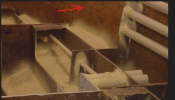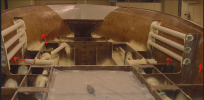1999 30' Grady - Bimini 306 - Center Console
I recently had my boat transported to the boat yard where some work is going to be done on engines (2023 Suzuki 250s)
I noticed there was a scuff mark 4 feet back from the rear of the boat.
The transport strapping scuffed the bottom paint onto the gelcoat from the tiedown being removed. There was also a small chip in the gelcoat which was not previously there. <sigh>
While I was getting ready to buff out the scuff mark I noticed the gelcoat has become delaminated in a pretty large area perhaps 18" above the water line (and a few inches below also).
It spans the length of the boat about 3-4 feet. More pronounce above the water line.
What should I expect for repair on this? Does the gelcoat need to be cut off to inspect the balsa? Or does the area need to be injected with resin?
Has anyone had this problem? Cost of repair?
There is no access from the console area without cutting into the sides of the boat where the rod holders are located. So I just don't know what kind of a job this is.
Coincidentally, I am having the boat appraised on monday because I'm moving to a different insurance company. I wonder what else he will find.
Any help/advice/previous experience on the delamination would be appreciated.
Ed
I recently had my boat transported to the boat yard where some work is going to be done on engines (2023 Suzuki 250s)
I noticed there was a scuff mark 4 feet back from the rear of the boat.
The transport strapping scuffed the bottom paint onto the gelcoat from the tiedown being removed. There was also a small chip in the gelcoat which was not previously there. <sigh>
While I was getting ready to buff out the scuff mark I noticed the gelcoat has become delaminated in a pretty large area perhaps 18" above the water line (and a few inches below also).
It spans the length of the boat about 3-4 feet. More pronounce above the water line.
What should I expect for repair on this? Does the gelcoat need to be cut off to inspect the balsa? Or does the area need to be injected with resin?
Has anyone had this problem? Cost of repair?
There is no access from the console area without cutting into the sides of the boat where the rod holders are located. So I just don't know what kind of a job this is.
Coincidentally, I am having the boat appraised on monday because I'm moving to a different insurance company. I wonder what else he will find.
Any help/advice/previous experience on the delamination would be appreciated.
Ed





